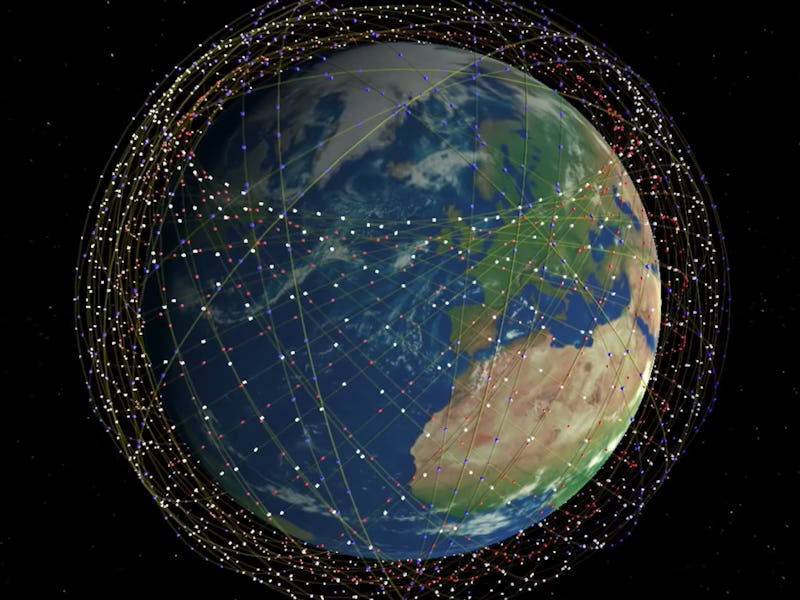SpaceX Starlink: More Astronomers Say Elon Musk’s Plan May Hamper Research
The Royal Astronomical Society is concerned.

Elon Musk’s plan to launch thousands of internet-beaming satellites into into low orbit could help close the digital divide, but astronomers are increasingly worried about downstream effects. Specifically, an influential group of astronomers recently warned arrays like Starlink could “compromise astronomical research.”
The latest warning is from the Royal Astronomical Society, a nearly 200-year-old group in the United Kingdom with over 4,000 members. In a new statement, the organization said they remain concerned that the crafts could disrupt their work, despite assurances from Musk that that his satellites will be invisible to the naked eye and won’t hamper science.
“Increasing the number of satellites so significantly presents a challenge to ground-based astronomy,” the society said in a statement. “The deployed networks could make it much harder to obtain images of the sky without the streaks associated with satellites, and thus compromise astronomical research.”
The first 60 Starlink satellites just moments before they were deployed
SpaceX Starlink: How It Could Disrupt Research
In what very well be a recurring theme as entrepreneurs commercialize space, the substance of RAS’s claims is that too many satellites in space will make it harder to study the stars here on Earth. They say that initial images of Starlink suggest they will “exhibit frequent reflective flaring,” as a brief alignment with the sunlight and the Earth beams light down off of the panels. That means, despite their small size, they could shine a strong beam toward researchers and disrupt their view.
This flaring has already been observed in the 66-strong Iridium constellation, some of them appearing brighter than Venus in the sky. The replacement Iridium NEXT system, launched by SpaceX over a two-year upgrade described as the largest in history, uses a smaller design that doesn’t produce flares.
The older Iridium system garnered a devoted following of astrophotographers, who marked the decommissioning of the old constellation with the hashtag “flarewell.” But the society, far from declaring Starlink an exciting new era for space enthusiasts, is instead urging SpaceX to instead “consider the impact on human heritage” from filling the sky with twinkling trinkets.
“Given the scale of these projects, there is also the prospect of a significant and lasting change to the views of the night sky until now enjoyed throughout human history and pre-history,” the society stated. “The night sky is part of the cultural heritage of humanity, and the Society believes that it deserves protection.”
The Falcon 9 packed with 60 Starlink test satellites.
Starlink, which beams internet down from the sky, will be huge. The company plans to launch 4,409 satellites for the initial constellation. Considering how there is only around 5,000 satellites in the sky in total, that would essentially double the number of crafts around the Earth. Around 1,584 will orbit at just 550 kilometers from the Earth, while the others will orbit around 1,150 kilometers.
The $10 billion system could offer latency low enough to play video games, beating existing satellite systems, while using lasers to communicate with each other faster than the fiber optic cables that currently cross the Earth. A receiver the size of a pizza box receives signals from the sky, creating an accessible network wherever the receiver can see the crafts.
The firm sent up 60 test satellites in May, packed into the fairing of a Falcon 9, with each one measuring to what Spaceflightnow refers to as “around the size of a mini-refrigerator.” When the first images from these test satellites hit the internet, however, the society grew concerned about the flares.
Musk has mostly dismissed the claims: “There are already 4900 satellites in orbit, which people notice ~0% of the time. Starlink won’t be seen by anyone unless looking very carefully & will have ~0% impact on advancements in astronomy. We need to move telelscopes to orbit anyway. Atmospheric attenuation is terrible.”
The society, responding to this claim that Musk will aim to minimize impact, stated that they “welcome” the offer and urge SpaceX and others to “work with scientists, engineers and others to mitigate the effects of the new constellations.”
But with Amazon also planning to launch the very similar Project Kuiper, and providers like OneWeb planning mega-constellations, astronomers may have more concerns than just SpaceX in the future.